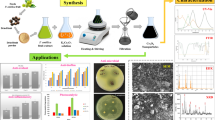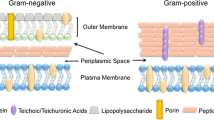Abstract
Derivatives of benzoic acid, glyoxylic acid benzhydrazone, oxanilic acid and N-dihydroxybenzylidene-2,4,6-trimethylaminobenzene were investigated as catecholic iron chelators under iron-depleted conditions. Some of the compounds showed strong positive reactions in the universal chemical siderophore assay (CAS): 3,4-dihydroxybenzoic acid, glyoxylic acid 2,3-dihydroxybenzhydrazone, N-3,4-dihydroxybenzylidene-2,4,6-trimethylaminobenzene. In particular these compounds also enabled removal of iron from iron-saturated transferrin. Using various siderophore indicator strains (enterobacteriacecae, Pseudomonas aeruginosa and Aeromonas hydrophila mutants) in bioassays the following growth promotion could be detected: vicinal substituents (e.g. 2,3- or 3,4-) were essential, the carboxyamido group seen in benzoic acids and glyoxylic acid benzhydrazones contributed to a positive reaction as well as the azomethin group (in N-3,4-dihydroxybenzylidene-2,4,6-trimethylaminobenzene). 2,3-Dihydroxybenzoic acid and the 2,3-diacetoxy substitute preferably promoted growth of enterobacteriaceae mutants. In contrast, the 3,4- positioned compounds preferably promoted growth of P. aeruginosa mutants and A. hydrophila SB 22. Glyoxylic acid di(methoxycarbonyloxy)-benzhydrazones (2,3- and 3,4- positioned) including the 2,3-dihydroxy compound preferably enabled growth of the non-fermenters. N-3,4-dihydroxybenzylidene-2,4,6-trimethylaminobenzene supplied all mutants of Salmonella, Escherichia coli, Klebsiella, Morganella, P. aeruginosa and A. hydrophila with iron. Transport of glyoxylic acid 2,3-dihydroxybenzhydrazone depended on tonB, and required the involvement of the iron-regulated outer membrane proteins (IROMPs) FepA, Cir and Fiu.
Similar content being viewed by others
References
Beilstein. 1927 1929, 1932 Handbuch der Organischen Chemie. Berlin: Springer Verlag; 1a: Bd. X, Hauptwerk S 396, 1b: Bd. XII, Hauptwerk S 281, 1c: Ergänungsband S 174.
Bekemeier H, Hirschelmann R, Langer A, et al. 1989 Zur Pharmakologie der Lipoxygenasehemmer Oxphaman, 1-(2,5-Dihydroxybenzyliden)aminoadamantaten, und Oxphalin, 1-(3,4-Dihydroxybenzylidin)-2,4,6-trimethylanilin. Pharmazie 44, 550–555.
Crowley DE, Wang YC, Reid CPP, Szaniszlo PJ. 1991 Mechanisms of iron acquisition from siderophores by microorganisms and plants. Plant Soil 130, 179–198.
Curtis NAC, Eisenstadt RL, East SJ, Cornford RJ, Walther LA, White A. 1988 Iron-regulated outer membrane proteins of Escherichia coli K-12 and mechanism of action of catechol-substituted cephalosporins. Antimicrob Agents Chemother 32, 1879–1886.
Dionis JB, Jenny HB, Peter HH. 1991 Therapeutically useful iron chelators. In: Winkelmann, G. ed. Handbook of Microbial Iron Chelates. Boca Raton, FL: CRC Press.
Ford S, Cooper RA, Evans RW, Hider RC, Williams PH. 1988 Domain preference in iron removal from human transferrin by the bacterial siderophores aerobactin and enterochelin. Eur J Biochem 178, 477–481.
Hantke K. 1990 Dihydroxybenzoylserine—a siderophore for E. coli. FEMS Microbiol. Lett. 67, 5–8.
Heinisch L, Ulbricht H, Willitzer, H. 1992 Synthese und antibakterielle Wirksamkeit von Benzoylaminoacyl-Penicillinen und verwandten Verbindungen mit und ohne acylierte Catechol-Substituenten. Arzneim-Forsch 42, 668–673.
Heinisch L, Möllmann U, Tresselt D, Willitzer H. 1993 Synthese und antibakterielle Wirkung neuer Ureidound Dicarbonsäurediamido-Derivate von Acylpenicillinen mit und ohne Catecholsubstitutenten. Arzneim-Forsch, in press.
Jadhav RS, Desai AJ. 1992 Isolation and characterization of siderophore from cow pea Rhizobium (peanut isolate). Curr Microbiol 24, 137–143.
Jurkevitch E, Hadar Y, Chen Y, Libman J, Shanzer A. 1992 Iron uptake and molecular recognition in Pseudomonas putida: receptor mapping with ferrichrome and its biomimetic analogs. J Bacteriol 174, 78–83.
McKee JA, Sharma SK, Miller MJ. 1991 Iron transport mediated drug delivery systems: synthesis and antibacterial activity of spermidine- and lysine-bases siderophore-β-lactam conjugates. Bioconjugate Chem 2, 281–287.
Nuhn P, Büge A, Köhler T, Lettau H, Schneider R. 1991 Trends bei der Entwicklung von Lipoxygenase-Hemmern. Pharmazie 46, 81–88.
Poole K, Young L, Neshat S. 1990 Enterobactin-mediated iron transport in Pseudomonas aeruginosa. J Bacteriol 172, 6991–6996.
Poole K, Neshat S, Heinrichs D. 1991 Pyoverdine-mediated iron transport in Pseudomonas aeruginosa: involvement of a high-molecular-mass outer membrane protein. FEMS Microbiol Lett 78, 1–6.
Rabsch W, Reissbrodt R. 1992 Eisenversorgung von Bakterien und ihre Bedeutung fur den infektiösen Prozeβ. Bioforum 15, 10–15.
Rabsch W, Winkelmann G. 1991 The specificity of bacterial siderophore receptors probed by bioassays. Biol Metals 4, 244–250.
Ratledge C, Chaudrey M. 1971 Accumulation of ironbinding phenolic acids by actinomycetales and other organisms related to mycobacteria. J Gen Microbiol 66, 7–11.
Reissbrodt R, Rabsch W. 1988 Further differentiation of Enterobacteriaceae by means of siderophore-pattern analysis. Zbl Bakt Hyg A 268, 306–317.
Reissbrodt R, Rabsch W. 1992 Quality of siderophore bioassays. Poster at the 3th Int Symp on Iron Transport, Storage and Metabolism, Strasbourg, France, 1992.
Reissbrodt R, Rabsch W. 1993Selective preenrichment of Salmonella from eggs by siderophore supplements. Zbl Bakt, in press.
Saxena B, et al. 1986 Isolation and characterization of siderophores from Azospirillum lipoferum D-2. J Gen Microbiol 132, 2219–2224.
Schwyn B, Neilands JB. 1987 Universal chemical assay for detection and determination of siderophores. Anal Biochem 160, 47–56.
Shanzer A. Libman J. 1991 Biomimetic siderophores. In: Winkelmann G, ed. Handbook of Microbial Iron Chelates. Boca Raton, FL: CRC Press.
Sokol PA. 1987 Tn5 insertion mutants of Pseudomonas aeruginosa deficient in surface expression of ferripyochelin-binding protein. J Bacteriol 169, 3365–3368.
Tabor E, Kim CM. 1991 Inhibition of human hepatocellular carcinoma and hepatoblastoma cell lines by desferoxamine. J Med Virol 34, 45–50.
Ulbricht H, Bekemeier H, Hirschelmann R, Grupe R, Böhme B, Weber FG. 1987 Verfahren zur Herstellung von neuen Azomethinen und ihrer Derivate. DDR-Patent DD 258804.
Watanabe NA, Nagasu T, Katsu K, Kitoh K. 1987 E-0702, a new cephalosporin, is incorporated into Escherichia coli cells via the tonB-dependent iron transport system. Antimicrob Agents Chemother 31, 497–504.
Westervelt P, Bloom ML, Mabbott GA, Fekete FA. 1985 The isolation and identification of 3,4-dihydroxybenzoic acid formed by nitrogen-fixing Azomonas macrocytogenes. FEMS Microbiol Lett 30, 331–336.
Winkelmann G. 1991 Handbook of Microbial Iron Chelates. Boca Raton, FL: CRC Press.
Winkelmann G, van der Helm D, Neilands JB. 1987 Iron Transport in Microbes, Plants and Animals. Weinheim: VCH Verlagsgesellschaft.
Author information
Authors and Affiliations
Rights and permissions
About this article
Cite this article
Reissbrodt, R., Heinisch, L., Möllmann, U. et al. Growth promotion of synthetic catecholate derivatives on Gram-negative bacteria. Biometals 6, 155–162 (1993). https://doi.org/10.1007/BF00205854
Received:
Accepted:
Issue Date:
DOI: https://doi.org/10.1007/BF00205854




